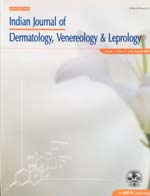
|
Indian Journal of Dermatology, Venereology and Leprology
Medknow Publications on behalf of The Indian Association of Dermatologists, Venereologists and Leprologists (IADVL)
ISSN: 0378-6323
EISSN: 0378-6323
Vol. 73, No. 5, 2007, pp. 333-335
|
 Bioline Code: dv07122
Bioline Code: dv07122
Full paper language: English
Document type: Research Article
Document available free of charge
|
|
|
Indian Journal of Dermatology, Venereology and Leprology, Vol. 73, No. 5, 2007, pp. 333-335
| en |
Brief Report - Clinicoepidemiological profile of 590 cases of beetle dermatitis in western Orissa
Padhi, T.; Mohanty, P.; Jena, S.; Sirka, C.S. & Mishra, S.
Abstract
Background: Beetle dermatitis is a very common condition in western Orissa. It is often misdiagnosed and causes significant morbidity among the rural population.
Aim: This study was conducted to determine the epidemiological and clinical profile of beetle dermatitis in western Orissa.
Methods: All clinically diagnosed cases of beetle dermatitis were included in the study. Detailed history was taken and thorough clinical examination was conducted in all the cases. One urban and three rural localities were visited regularly to detect the epidemiological trends of the disorder.
Results: A total of 590 cases were studied: 486 males and 104 females. The age of the patients ranged from 2 to 65 years. Forty-four percent of the patients belonged to the pediatric age group. Majority of the cases (85%) presented during the months of March to July, indicating a distinct seasonal trend. The disorder was prevalent in the localities nearer to paddy and sugarcane fields and grasslands with stagnant water. The clinical lesions included papules, erosions, crusted lesions, urticarial plaques and vesiculobullous lesions. Distribution was mainly linear, but kissing lesions were also observed. Head, neck and upper extremities were the most commonly involved sites. Lymphadenopathy and systemic features such as fever and malaise were observed in 24% and 15% of the cases, respectively.
Conclusion: Beetle dermatitis should be included in the differential diagnosis of the acute onset of vesiculobullous lesions in the endemic areas.
Keywords
Beetle dermatitis, Kissing lesions
|
| |
© Copyright 2007 Indian Journal of Dermatology, Venereology and Leprology.
Alternative site location: http://www.ijdvl.com
|
|
